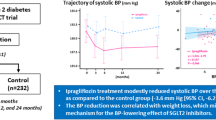Abstract
We investigated the possible role of losartan on insulin-mediated glucose uptake, substrate oxidation and blood flow in insulin-resistant hypertensive patients. Sixteen newly diagnosed patients with mild-to-moderate hypertension were studied. The study design was a single-blind, randomised, placebo-controlled trial. After a 1 week run-in period, each patient was randomly assigned to placebo (n = 7) and losartan (n = 9). Both treatment periods lasted 4 weeks. At baseline, and at the end of the placebo and losartan treatment periods, euglycaemic hyperinsulinaemic glucose clamp and indirect calorimetry were performed. Before and along each glucose clamp, blood flow was also determined in the femoral artery by image-directed duplex ultrasonography combining B-mode imaging and pulse Doppler beams. Losartan vs placebo lowered systolic blood pressure by 163 ± 3.5 and 147 ± 4.1 mm Hg (P < 0.001), and diastolic blood pressure by 95 ± 3.2 and 85 ± 3.2 mm hg (P < 0.001). losartan enhanced glucose metabolic clearance rate by 5.1 ± 0.3 and 6.3 ± 0.4 mg/kg × min (P < 0.05), and whole body glucose disposal (wbgd) by 29.2 ± 0.5 and 38.1 ± 0.4 μ mol/kg free fatty mass (FFM) × min (P < 0.01) but did not affect heart rate. insulin-mediated change in blood flow was greater after losartan than placebo administration (111 ± 4 vs 84 ± 3%, P < 0.01). per cent change in insulin-mediated stimulation of blood flow and wbgd were also correlated (r = 0.76, P < 0.01). analysis of substrate oxidation revealed that losartan adminstration improved insulin action and non-oxidative glucose metabolism (nogm) (30.8 ± 2.2 vs 22.8 ± 2.8 μmol/kg FFM × min, P < 0.05). in conclusion losartan improves insulin-mediated glucose uptake through an increase in nogm and blood flow in hypertensive patients.
This is a preview of subscription content, access via your institution
Access options
Subscribe to this journal
Receive 12 digital issues and online access to articles
$119.00 per year
only $9.92 per issue
Buy this article
- Purchase on Springer Link
- Instant access to full article PDF
Prices may be subject to local taxes which are calculated during checkout
Similar content being viewed by others
Author information
Authors and Affiliations
Rights and permissions
About this article
Cite this article
Paolisso, G., Tagliamonte, M., Gambardella, A. et al. Losartan mediated improvement in insulin action is mainly due to an increase in non-oxidative glucose metabolism and blood flow in insulin-resistant hypertensive patients. J Hum Hypertens 11, 307–312 (1997). https://doi.org/10.1038/sj.jhh.1000434
Received:
Revised:
Accepted:
Issue Date:
DOI: https://doi.org/10.1038/sj.jhh.1000434
Keywords
This article is cited by
-
Impact of sitagliptin combination therapy and hypoglycemia in Japanese patients with type 2 diabetes: a multi-center retrospective observational cohort study
Journal of Pharmaceutical Health Care and Sciences (2020)
-
Different angiotensin receptor blockers and incidence of diabetes: a nationwide population-based cohort study
Cardiovascular Diabetology (2014)
-
Effects of angiotensin II receptor blockers on insulin resistance
Hypertension Research (2010)
-
Possible pathophysiologic mechanisms supporting the superior stroke protection of angiotensin receptor blockers compared to angiotensin-converting enzyme inhibitors: clinical and experimental evidence
Journal of Human Hypertension (2005)
-
Angiotensin and insulin resistance: Conspiracy theory
Current Hypertension Reports (2003)



